
The Aesthetics and Styles of Cloud Rap
Cloud Rap as a genre focuses very heavily on aesthetics, style, and sonic texture. Visually, Cloud Rap displays an emphasis on the mundane and liminal spaces in life, as well as an ironic focus on outdated technology. In creating this website, I have tried to encapsulate the visual aesthetic and mood of Cloud Rap.

The Visual Style of Cloud Rap
Cloud Rap has a very heavy emphasis on visuals, not only in album artwork but in music videos as well. While there are distinct sonic differences between artists, the general aesthetics and styles remain relatively the same. One of the biggest influences in Cloud Rap's visual appearance is analog technology and the internet as a whole (I Write Raps Not Tragedies). Cloud Rap's aesthetic also focuses on mundane and liminal spaces, like malls or public access TV, which adds a strange irony to its style. Cloud Rap's aesthetic also focuses on material things, but not in the way you would think. There is an extremely strange trope in Cloud Rap to focus on gas station drinks and cigars. In Yung Lean's music and music videos, you can find multiple references to Arizona Iced Green Tea (hence the spinning gif) and references to Fiji Water and Backwoods cigars in the lyrics of many BONES songs. The Vice documentary on Yung Lean released earlier this year explores this trope and ponders the idea that it could be a commentary on the materialism of Hip-Hop, but no definitive answer is given (Yung Lean: In My Head). The aspect of Cloud Rap's style and aesthetic that made me want to embark on this project in the first place is Western Cloud Rap's near-obsession with Asian (specifically Japanese) culture. Pokemon cards, Nintendo, Kanji characters, and anime all play a very important part in the way Western Cloud Rap presents itself (I Write Raps Not Tragedies). Some of these visual styles also come into play sonically and can be found in the music of the genre, but I will discuss that in more depth later. Since demonstrating this style is a lot easier than trying to explain it, I will be using multiple music videos (which are on the playlist I included) and artwork from albums to show this aesthetic in action.
1) Weather Man- Xavier Wulf & BONES (track 21)
This music video (considered a classic by fans of the genre) features the hallmark VHS home movie aesthetic that can be found in many Cloud Rap music videos. The VHS and DIY filming and editing of these videos show how much media in this genre is self-produced and independently distributed. Additionally, it features an (intentionally poorly edited) greenscreen displaying weather forecasts, most likely from the 80s or 90s. This demonstrates Cloud Rap's fixation on the more boring aspects of life and its attempts to bring some sort of ironic life to them. Personally, I think the use of liminal spaces and dated technology is meant to be both nostalgic and a joke. While things like weather forecasts and late 90s to early 2000s technology can invoke a sense of childhood nostalgia in the viewer, there's some humor to be found in rapping about being angry at the world and smoking marijuana in front of a Weather Channel forecast.
2) Flossing- 6Dogs (track 17)
This video continues the self-produced home movie feeling found in Weather Man. The fact that it seems to be filmed in a basement gives the video a sense of intimacy with the viewer, as do the lyrics. Several important things to note in the video are the appearance of both a bottle of cough syrup and a gallon of Arizona Iced Tea at 0:38 and the episodes of the anime One Piece being projected on a wall in the background. These things show both Cloud Rap's weird sense of materialism, its heavy drug influence, and its fixation on aspects of Japanese culture.
3) Hurt- Yung Lean (track 9)
In my opinion, Yung Lean's Hurt music video best encapsulates the aesthetic of Cloud Rap as a whole. If somebody wanted me to explain Cloud Rap in one minute, I'd show them the first minute of Hurt. The music video starts off with the corniest 90s CGI landscapes someone could find before Kanji characters are displayed on the screen along with the song title. It then features Yung Lean rapping while a poorly edited greenscreen displays every Cloud Rap trope it can. Gameboys, Nintendo cartridges and controllers, pokemon cards, Arizona Iced Tea, cough syrup, and references to early 00s internet all make an appearance. Additionally, the whole video looks like Yung Lean tried really hard to make it look like he didn't try at all. This all shows the strange fixation on mundane things and Asian culture that Cloud Rap has, as well as its tendency to pump up the irony so much you can't tell if it's serious or a joke. This music video personally fascinates me as every time I watch it, something new catches my eye (like the word "Gatorade" appearing at 2:32) and it boggles my mind thinking someone sat down and thought about making this.
4) 1996- Tohji
The album artwork for Japanese artist Tohji's 2017 album 1996 takes a lot of inspiration from Yung Lean's Hurt. The seemingly random inclusion of old Gatorade bottles in the album artwork shows the way that Western Cloud Rap has influenced its artists in the East. Additionally, the poorly photoshopped picture of Tohji's head in the middle of the cover adds to the apathy that Cloud Rap emanates. Behind the Gatorade bottles and Tohji's head is what seems to be a mall food court, demonstrating the emphasis on mundane and often liminal spaces. The anglicized Kanji characters showing the album title and artist's name somehow both pay homage to the Western Cloud Rap's obsession with Japan and maintain the fact that Tohji is a Japanese artist.
5) ダサい (Lame)- BONES & Xavier Wulf
The album artwork for BONES and Xavier Wulf's collaborative album is another example of Cloud Rap's VHS aesthetic. The damaged VHS static covers the faces of both artists creates a mood of mystery and anonymity both of which can be related to the relative anonymity internet users can hide behind, alluding to the internet presence of the genre. Additionally, the title of this album is featured in Japanese on the front and the title of every track on this album is in Japanese with English in parentheses (another example of Cloud Rap borrowing Japanese culture and aesthetics).


The Sonic Style of Cloud Rap
One of the best ways to describe the sound of Cloud Rap was said by Lil B in a 2009 interview. Lil B described the genre's sound by pointing at a CGI picture of a castle in the clouds saying "that's the kind of music I want to make" (Whatever happened to hip-hop subgenre cloud-rap?). While this is an accurate description of Cloud Rap's sonic style, I want to explore the textures and aesthetics of the genre's songs more thoroughly. There are two distinct categories that the musical styles of Cloud Rap can be placed into. The first category is the sound that Yung Lean pioneered in the early 2010s and the music it inspired. The second category is the more "hardcore" sound which takes its inspiration more from Memphis rap than Yung Lean or A$AP Rocky. Overall, Cloud Rap de-emphasizes wordplay and technical skill and instead focuses heavily on the texture of the sound and the mood created by it. (I Write Raps Not Tragedies).
This is not the picture Lil B referenced, it's from Miyazaki's Castle In the Sky
The production behind the Yung Lean style of Cloud Rap is very electronic inspired and can almost be described as Nintendo-esque. Much of the sampling and production used in songs like Hurt or Tohji's Veen Veeen! (track 19) sound like something you would hear in Mario Kart or a Zelda title. Hi-Hat trills and booming bass are also a common theme of Cloud Rap production. Another hallmark of production is the vocal samples, like Yung Lean's hypnotic sample of Japanese electronic artist De De Mouse in Ginseng Strip 2002. In terms of vocals, it's very common for Cloud Rap songs to employ heavy use of autotune or double-tracking the vocals to make one person sound like multiple. The vocal delivery is normally very monotone and stunted and occasionally lines are sung, serving to create a more spacey ethereal sound. As I mentioned earlier, Cloud Rap is focused on the texture of its sound, so the production and vocal style is all centered around the mood and feeling created by it. In the Yung Lean style of Cloud Rap, the more the song sounds like you ripped it out of a Windows 2002 computer, the better. The lyrical content is also a bit off-the-beaten-path for what you would expect in rap music at the time. You'll hear references to designer clothes and expensive cars, juxtaposed with references to Pokemon, lyrics about mental illness, and discussion of heavy drug addiction. While drug addiction and mental health have been at the forefront of Hip-Hop music recently, for the time it was a unique perspective. Additionally, because of the simplicity of the rapping, Cloud Rap is a very brutally honest genre. It does not hide its meaning behind metaphors or lyrical devices and artists do not pull punches when telling you how they are feeling. One of the best examples of this is Yung Lean's song Agony, written after a cocaine overdose and his subsequent stay in a psychiatric hospital. While the song barely touches the hallmark production style of his earlier work, the lyrics paint a portrait of a lonely and pained artist bearing his feelings to the world. While the more Memphis-influenced style of Cloud Rap shares a lot of this specific style, there are some key differences I think are worth highlighting.
The Memphis-Influenced Cloud Rap shows a much darker side of the subgenre. While its aesthetics also focus on liminal spaces like those mentioned above, often it can veer closer to horror aesthetics than anything else. Notable artists $uicideboy$ are known to sample laughter from horror movies or horror anime in the intros of their songs. On the production side of things, this type of Cloud Rap has more stripped down production and can be minimalist at times compared to their contemporaries. There is still a focus on atmospheric and eclectic sampling as well as female vocal samples, which can be seen in the popular $uicideboy$ song Antarctica (track 26). The vocal samples are often darker and more melancholy like in Chris Travis' song Sci-Fi (track 29). It's also common for old Memphis rap songs to be sampled, like in BONES' CokeWhiteCaddy (track 29). It's rare for the vocals to include autotune, though it's not unheard of, and the double tracking of vocals is extremely common. The lyrics also contain references to drug use, a discussion of mental health, and references to internet culture much like Yung Lean. The main difference in the lyrics is the violence that is common in these songs. Many of the lyrics of $uicideboy$ and the SESH collective's songs will often reference murder, robbery, and about 100 euphemisms for guns. Due to the dark nature of this type of Cloud Rap, it is not uncommon for the vocal styles and aesthetics to be compared to the Norwegian Black Metal scene (Welcome to Hell). It's easy to see the comparison when listening to songs like $atsuki's satu (track 30), in which the vocals are more like those of Metal or Punk than like rapping.
The aesthetics of Cloud Rap are diverse, strange, and fascinating. Often the fixation on nostaliga, Japanese culture, and the unflinching melancholy on the subgenre can at times be off-putting. However, this is what has always fascinated me about the genre and what made me want to pursue this project in the first place. Because of its internet focus and multicultural influence, Cloud Rap's sonic and visual aesthetics can be used without anyone claiming it as their own. It's lyrics touch on issues anybody can face and it's nostalgic visual presence can appeal to anyone growing up in the time that these artists did. The aesthetics of Cloud Rap are rooted in shared experiences and anyone seen using a similar style as someone else isn't accused of stealing their ideas. Cloud Rap is an intimate collective community, which is why I think it can function as a "global" genre.




















